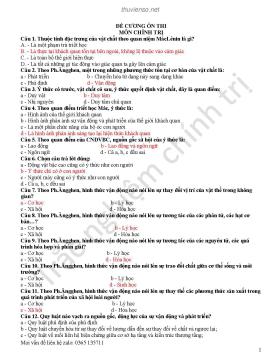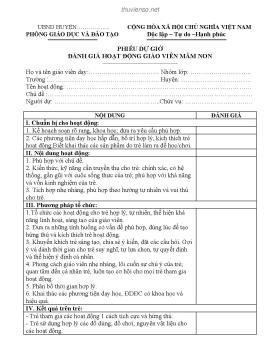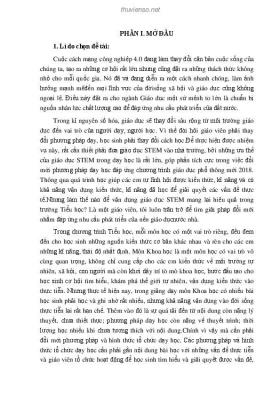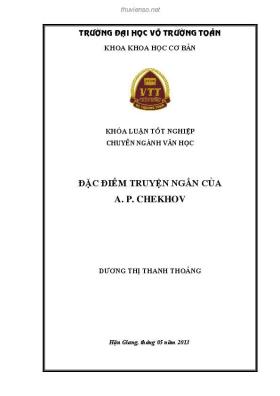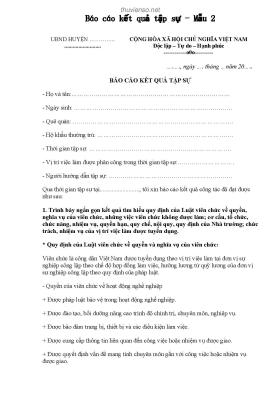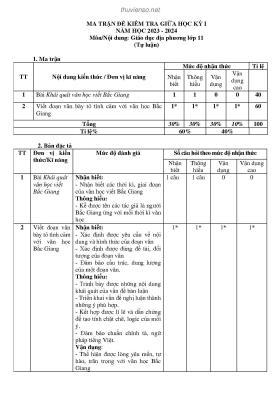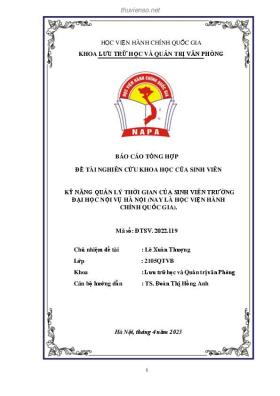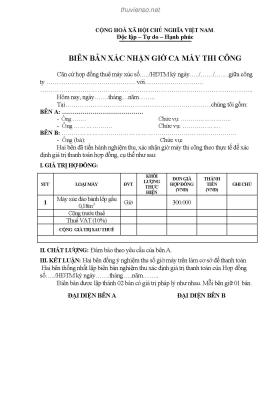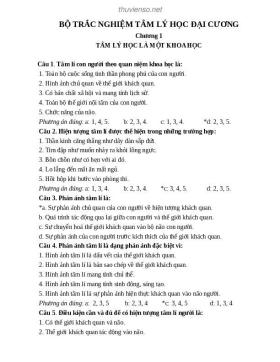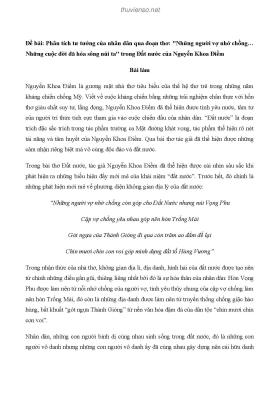
Handbook of Air Pollution Prevention and Control
Số trang: 582
Loại file: pdf
Dung lượng: 13.32 MB
Lượt xem: 19
Lượt tải: 0
Xem trước 10 trang đầu tiên của tài liệu này:
Thông tin tài liệu:
This Handbook provides a concise overview of the latest technologies for managing industrial air pollution in petrochemical, oil and gas, and allied industries. Detailed material on equipment selection, sizing, and troubleshooting operations is provided along with practical design methodology. Unique to this volume are discussions and information on energy-efficient technologies and approaches to implementing environmental cost accounting measures.
Included in the text are sidebar discussions, questions for thinking and discussing, recommended resources for the reader (including Web sites), and a comprehensive glossary.
The Handbook of Air Pollution Prevention and Control also includes free access to US EPA's air dispersion model SCREEN3. Detailed...
Nội dung trích xuất từ tài liệu:
Handbook of Air Pollution Prevention and Control Handbook of Air Pollutio Prevention Control rg ..’ HANDBOOK OF AIR POLLUTION PREVENTION AND CONTROL HANDBOOK OF AIR POLLUTION PREVENTION AND CONTROL Nicholas P. Cheremisinoff, Ph.D. N &P Limited P=-=EINEMANN An imprint of Elsevier Science Amsterdam Boston London New York Oxford Paris San Diego San Francisco Singapore Sydney Tokyo Butterworth-Heinemann is an imprint of Elsevier Science. Copyright 02002, Elsevier Science (USA). All rights reserved. No part of this publication may be reproduced, stored in a retrieval system, o r transmitted in any form or by any means, electronic, mechanical, photocopying, recording, or otherwise, without the prior written permission of the publisher. @ Recognizing the importance of preserving what has been written, Elsevier Science prints its books on acid-free paper whenever possible. Library of Congress Cataloging-in-Publication Data Cheremisinoff, Nicholas P. Handbook of air pollution prevention and control / Nicholas P. Cheremisinoff. p. cm. Includes bibliographical references and index. ISBN 0-7506-7499-7 (alk. paper) 1. Air quality management. 2. Air-Pollution. 3. Factory and trade waste-Environmental aspects. I . Title. TD883 .C435 2002 628.5’34~21 20020 18563 British Library Cataloguing-in-Publication Data A catalogue record for this book is available from the British Library. The publisher offers special discounts on bulk orders of this book. For information, please contact: Manager of Special Sales Elsevier Science 225 Wildwood Avenue Woburn, MA 01801-2041 Tel: 781-904-2500 Fax: 78 1-904-2620 For information on all Butterworth-Heinemann publications available, contact our World Wide Web home page at: http://www.bh.com 10987654321 Printed in the United States of America CONTENTS Preface, vii About the Author, xi Chapter 1. Introduction to Air Quality, 1 Introduction, 1 An Overview of the Clean Air Act Amendments, 1 Fate and Transport in the Environment, 9 A Few of the Priority Air Pollutants, 15 Indoor Air Quality, 42 Organization of Handbook Subjects, 48 Recommended Resources for the Reader, 51 Review and Questions to Get You Thinking, 51 Chapter 2. Industrial Air Pollution Sources and Prevention, 53 Introduction, 53 Air Pollution in the Chemical Process Industries, 53 Air Pollution in the Petroleum Industry, 79 Air Pollution from Iron and Steel Manufacturing, 112 Air Pollution from Lead and Zinc Smelting, 130 Air Pollution from Nickel Ore Processing and Refining, 134 Air Pollution from Aluminum Manufacturing, 137 Air Pollution from Copper Smelting, 141 Recommended Resources for the Reader, 144 Review and Questions to Get You Thinking, 146 Chapter 3. Properties of Air Pollutants, 148 Introduction, 148 Selected Chemical and Physical Properties of Potential Atmospheric Pollutants, 148 Basic Properties and Terminology, 158 Accessing the World-Wide Web for Data Bases, 183 Recommended Resources for the Reader, 184 Review and Questions to Get You Thinking, 186 Chapter 4 . Ventilation and Indoor Air Quality Control, 188 Introduction, 188 An Overview of Indoor Air Quality, 188 The Basics of HVAC Systems, 191 V IAQ Issues and Impacts on Occupants, 195 Application of Audits to Developing an IAQ Profile, 200 Developing Management Plans, 206 How to Diagnose IAQ Problems, 213 Control, 228 Quantification and Measurement, 238 Recommended Resources for the Reader, 278 Review and Questions to Get You Thinking, 279 Chapter 5. Air Pollution Dispersion, 28 1 Introduction, 281 Dispersion Theory Basics, 282 Estimating the Air Quality Impact of Stationary Sources, 297 Other Models and Resources, 326 Case Study Applying SCREEN, 335 References and Recommended Resources for the Reader, 342 Review and Questions to Get You Thinking, 344 Chapter 6. Prevention Versus Control, 348 Introduction, 348 Pollution Prevention: When and How, 350 Principles of Pollution Prevention, 356 References and Recommended Resources for the Reader, 384 Review and Questions to Get You Thinking, 387 Chapter 7 . Prevention and Control Hardware, 389 Introduction, 389 Methods of Particulate Collection, 389 Methods for Cleaning Gaseous Pollutants, 446 References and Recommended Resources for the Reader, 488 Chapter 8. Environmental Cost Accounting, 498 Introduction, 498 Total Cost Accounting Terminology, 500 Case Study, 512 Glossary, 5 15 Index, 553 vi This volume covers the practices and technologies that are applied to the prevention of air pollution, and to the cleaning and control of industrial air emissions. Although there are numerous publications that address these subjects, rarely are prevention and control concepts considered together in a single volume. This book provides a bridge for today’s environmental manager by focusing on an integrated approach to managing air pollution problems within industrial operations. There are eight chapters. Chapter 1 provides orientation and an introduction to the subject of air quality. The focus of this book is on industrial air pollution problems. We begin by reviewing the regulatory driving force in the United States for air pollution abatement. To appreciate the objectives of our Federal air pollution control regulations, an understanding of the fate and transport mechanisms in the environment is important. Hence, some general discussions on the behavior of pollutants in the atmosphere are included in this chapter. There are only two general methods for ensuring high quality air. These options are the applica ...
Nội dung trích xuất từ tài liệu:
Handbook of Air Pollution Prevention and Control Handbook of Air Pollutio Prevention Control rg ..’ HANDBOOK OF AIR POLLUTION PREVENTION AND CONTROL HANDBOOK OF AIR POLLUTION PREVENTION AND CONTROL Nicholas P. Cheremisinoff, Ph.D. N &P Limited P=-=EINEMANN An imprint of Elsevier Science Amsterdam Boston London New York Oxford Paris San Diego San Francisco Singapore Sydney Tokyo Butterworth-Heinemann is an imprint of Elsevier Science. Copyright 02002, Elsevier Science (USA). All rights reserved. No part of this publication may be reproduced, stored in a retrieval system, o r transmitted in any form or by any means, electronic, mechanical, photocopying, recording, or otherwise, without the prior written permission of the publisher. @ Recognizing the importance of preserving what has been written, Elsevier Science prints its books on acid-free paper whenever possible. Library of Congress Cataloging-in-Publication Data Cheremisinoff, Nicholas P. Handbook of air pollution prevention and control / Nicholas P. Cheremisinoff. p. cm. Includes bibliographical references and index. ISBN 0-7506-7499-7 (alk. paper) 1. Air quality management. 2. Air-Pollution. 3. Factory and trade waste-Environmental aspects. I . Title. TD883 .C435 2002 628.5’34~21 20020 18563 British Library Cataloguing-in-Publication Data A catalogue record for this book is available from the British Library. The publisher offers special discounts on bulk orders of this book. For information, please contact: Manager of Special Sales Elsevier Science 225 Wildwood Avenue Woburn, MA 01801-2041 Tel: 781-904-2500 Fax: 78 1-904-2620 For information on all Butterworth-Heinemann publications available, contact our World Wide Web home page at: http://www.bh.com 10987654321 Printed in the United States of America CONTENTS Preface, vii About the Author, xi Chapter 1. Introduction to Air Quality, 1 Introduction, 1 An Overview of the Clean Air Act Amendments, 1 Fate and Transport in the Environment, 9 A Few of the Priority Air Pollutants, 15 Indoor Air Quality, 42 Organization of Handbook Subjects, 48 Recommended Resources for the Reader, 51 Review and Questions to Get You Thinking, 51 Chapter 2. Industrial Air Pollution Sources and Prevention, 53 Introduction, 53 Air Pollution in the Chemical Process Industries, 53 Air Pollution in the Petroleum Industry, 79 Air Pollution from Iron and Steel Manufacturing, 112 Air Pollution from Lead and Zinc Smelting, 130 Air Pollution from Nickel Ore Processing and Refining, 134 Air Pollution from Aluminum Manufacturing, 137 Air Pollution from Copper Smelting, 141 Recommended Resources for the Reader, 144 Review and Questions to Get You Thinking, 146 Chapter 3. Properties of Air Pollutants, 148 Introduction, 148 Selected Chemical and Physical Properties of Potential Atmospheric Pollutants, 148 Basic Properties and Terminology, 158 Accessing the World-Wide Web for Data Bases, 183 Recommended Resources for the Reader, 184 Review and Questions to Get You Thinking, 186 Chapter 4 . Ventilation and Indoor Air Quality Control, 188 Introduction, 188 An Overview of Indoor Air Quality, 188 The Basics of HVAC Systems, 191 V IAQ Issues and Impacts on Occupants, 195 Application of Audits to Developing an IAQ Profile, 200 Developing Management Plans, 206 How to Diagnose IAQ Problems, 213 Control, 228 Quantification and Measurement, 238 Recommended Resources for the Reader, 278 Review and Questions to Get You Thinking, 279 Chapter 5. Air Pollution Dispersion, 28 1 Introduction, 281 Dispersion Theory Basics, 282 Estimating the Air Quality Impact of Stationary Sources, 297 Other Models and Resources, 326 Case Study Applying SCREEN, 335 References and Recommended Resources for the Reader, 342 Review and Questions to Get You Thinking, 344 Chapter 6. Prevention Versus Control, 348 Introduction, 348 Pollution Prevention: When and How, 350 Principles of Pollution Prevention, 356 References and Recommended Resources for the Reader, 384 Review and Questions to Get You Thinking, 387 Chapter 7 . Prevention and Control Hardware, 389 Introduction, 389 Methods of Particulate Collection, 389 Methods for Cleaning Gaseous Pollutants, 446 References and Recommended Resources for the Reader, 488 Chapter 8. Environmental Cost Accounting, 498 Introduction, 498 Total Cost Accounting Terminology, 500 Case Study, 512 Glossary, 5 15 Index, 553 vi This volume covers the practices and technologies that are applied to the prevention of air pollution, and to the cleaning and control of industrial air emissions. Although there are numerous publications that address these subjects, rarely are prevention and control concepts considered together in a single volume. This book provides a bridge for today’s environmental manager by focusing on an integrated approach to managing air pollution problems within industrial operations. There are eight chapters. Chapter 1 provides orientation and an introduction to the subject of air quality. The focus of this book is on industrial air pollution problems. We begin by reviewing the regulatory driving force in the United States for air pollution abatement. To appreciate the objectives of our Federal air pollution control regulations, an understanding of the fate and transport mechanisms in the environment is important. Hence, some general discussions on the behavior of pollutants in the atmosphere are included in this chapter. There are only two general methods for ensuring high quality air. These options are the applica ...
Tìm kiếm theo từ khóa liên quan:
air pollution petrochemical oil and gas allied industries design methodologyGợi ý tài liệu liên quan:
-
Elite energy transitions: Leaders and experts promoting renewable energy futures in Norway
10 trang 35 0 0 -
English 6: Unit 11 - Our greener world
16 trang 32 0 0 -
The Impact of Communications Methods on Team's Productivity and Performance - Oil and Gas case study
10 trang 22 0 0 -
An assessment of sustainability disclosures in oil and gas listed companies in Nigeria
10 trang 20 0 0 -
Book: AIR QUALITY – NEW PERSPECTIVE
335 trang 19 0 0 -
Deep geological structure of An Chau trough base on new study data
11 trang 18 0 0 -
15 trang 16 0 0
-
Ebook Air pollution: Health and environmental impacts – Part 1
227 trang 16 0 0 -
Air Sampling and Industrial Hygiene Engineering
276 trang 15 0 0 -
AIR POLLUTION CONTROL TECHNOLOGY HANDBOOK
380 trang 13 0 0



